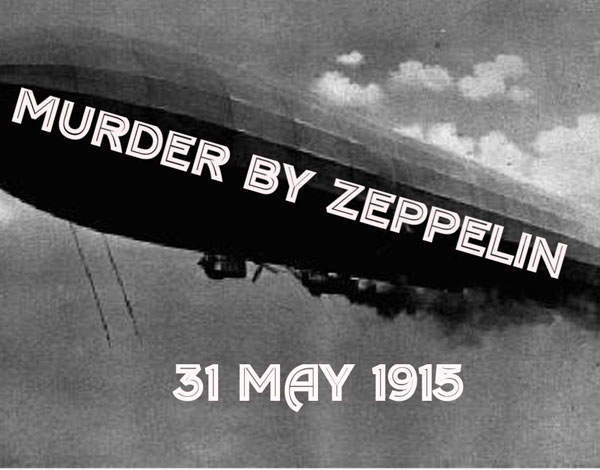

London’s Blitz in the Second World War being so much part of common consciousness, one doesn’t often pause to think that, actually, it had all happened previously. It was with somewhat lesser intensity admittedly: a total of ‘only’ 668 deaths from 1914 to 1918, with 2,000 injuries — a fraction of the 57,000 casualties suffered by British troops on the first day of the Battle of the Somme.
Yet it had enough persistence and effrontery to make civilian Londoners’ lives a misery for stretches of the four-year engagement.
Jerry White, one of our best social historians, outlines the contours of the Kaiser’s aerial bombing campaign with typical lucidity; he is a master story-teller who can’t write a dull sentence.
The terror came in two phases. First, from May 1915, were the airship raids, typically on moonlit nights (as the Germans were not yet able to navigate by radar) and more or less unpunished owing to the incompetence, or perhaps merely inexperience, of the British artillery defences.
That came to an end with a spectacular direct hit on the night of 1 October 1916, when the daring flying ace Heinrich Mathy’s Zeppelin was downed in a blazing fireball over Blackfriars Bridge, incinerating him and his crew of 22: just punishment, Londoners must have thought, for the arbitrary havoc he had wreaked.
The huge and ultimately vulnerable airships were replaced in the next stage of the conflict by a new deadly menace, squadrons of six-engine biplanes known as ‘Giants’ whose 138-foot wingspans, White informs us, were larger than those of any aeroplane that bombed London in the Second World War. For a year and a half (up until the beginning of 1918) the sporadic incursions across the North Sea of these terrifying machines, accompanied by the smaller but no less deadly ‘Gotha’ bombers, succeeded in keeping the capital in a permanent state of jitters.
If the material damage wasn’t unmanageable, the inconvenience was enormous, starting with the necessity of blackout that made whole sections of the city at night-time impossible to navigate. And of course you never knew where the damn things would strike next.
On 28 January 1918, for instance, a 300kg bomb fell on to Covent Garden and penetrated the pavement outside Odhams’ printing works, exploding in the cellars, severing the gas main and setting fire to the building. At which point, the rear wall of 92 Long Acre collapsed and with it floors carrying giant reels of newsprint ready for the press, which in turn fuelled the flames. Amid dreadful scenes, 38 people died and 85 were injured; some bodies were never recovered. It was the worst disaster caused by a single bomb in Britain during the First World War.
Yet life goes on, of course, ‘business as usual’ being part of the national character. And that included night life. Hotels and clubs stayed open during the conflict, as did brothels, cinemas, music halls and theatres. Troops on leave could sample long-running stage hits such as Chu Chin Chow and The Bing Boys Are Here, the latter starring music hall comedians George Robey and Alfred Lester, and containing one of the war’s sensational musical numbers, If You Were the Only Girl in the World.
In short, cheerfulness kept breaking out, as is its wont. White records for example, that at the beginning of 1916 fashionable women abandoned umbrellas as being dowdy, and began to sport mackintoshes in fantastic hues — pink, yellow and green. (Somehow one thinks of the First World War as being recorded for ever in staid black and white.) Meanwhile, in the darkest days of military setback, dance crazes, imported from America, swept the capital’s ballrooms.
The war itself was a liberation for women of all classes. At the lower end of the scale there was full employment and a decent wage packet to be had from work in the burgeoning munitions industry, or else as a ‘clippie’ on the London omnibuses. Higher up the social ladder we encounter hordes of charming middle-class secretaries administering the paperwork that poured forth in ever-increasing volume from the newly created ministries of Air, Food, Information etc.
Finally, at the apex of the pyramid, aristocratic women found a goal, in some cases for the first time, in dedicating themselves to the war-wounded who, arriving at major hubs like Charing Cross Station, poured into every hospital available.
London then, as London now, was a cosmopolitan city, but it is interesting to find out that, at the beginning of the war, the largest group of foreign nationals (apart from the East End Jews, but far outnumbering Italians and Frenchmen) were Germans and Austrians — 40,000 of them altogether, employed as bakers, barbers and waiters.
Though they were by and large well integrated, their position was a parlous one. If they didn’t return home at the beginning of hostilities (in fact, many escaped at the last moment) they were liable to mass internment — Alexandra Palace, for the duration of the war, becoming one such grim ‘concentration camp’. (That was the phrase that was used at the time, though of course without the full panoply of overtones that it bears nowadays.)
Nor were they the only ‘awkward foreigners’ disturbing the capital’s consensus. Some (but by no means all) of the aforementioned Jews proved themselves unhappy to sign up when compulsory conscription came in at the beginning of 1916, since our ally in the East, Russia, was one of their principal enemies. That only changed in March 1917, with the downfall of the Tsar — an occasion for mass East End rejoicing.
Each phase of the war is covered by Professor White in fascinating detail. He is as readable in discussing the intricacies of London’s employment statistics (one of the happier outcomes of the conflict being that the increase in the average wage helped destroy the worst effects of pre-war destitution) as he is in outlining the contours of major political crises such as the mid-war fall of the Asquith cabinet.
Further disasters, such as the epidemic of Spanish flu in the autumn of 1918 which, with cruel irony, wiped out a sizeable swathe of the population on the eve of Allied victory, are described with riveting particularity. White writes with the fluency of a novelist, and this book can be hugely recommended.








